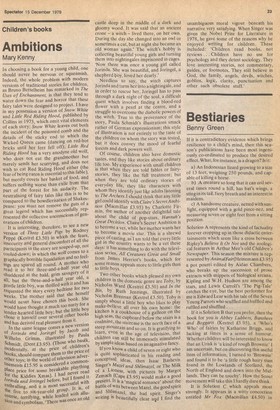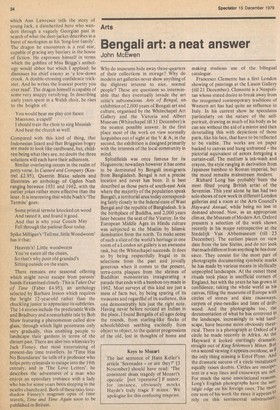Bestiaries
Benny Green
If it is contradictory evidence which brings resilience to a child's mind, then this season's publications have been most ingeniously co-ordinated to produce the desired effect. What, for instance, is a dragon? Is it: a) An Indonesian lizard growing to a size of 13 feet, weighing 250 pounds, and capable of killing a horse.
b) A creature so long that it can coil several times round a hill, has bat's wings, a sting in its tail, fiery breath and an interest in maidens.
c) A handsome creature, netted with sunlight, equipped with a gold pince-nez, and measuring seven or eight feet from a sitting position.
Solution A represents the kind of factuality forever cropping up in those didactic entertainments which seem like a cross between Ripley's Believe It Or Not and the zoological features in Arthur Mee's old Children's Newspaper. This season the mixture is represented by Anima/Fair(Heinemann £3.95) a pot pourri edited by Aidan Chambers, who breaks up the succession of prose extracts with snippets of biological arcana., Kipling and W.H. Hudson are among the stars, and Lewis Carroll's 'The Pig-Tale' catches the eye, but the best performer for me is Edward Lear with his tale of the Seven Young Parrots who scuffled and huffled and ruffled and shuffled. . .
If it is Solution B that you prefer, then the book for you is Abbey Lubbers, Banshees and Boggarts (Kestrel £5.95), a 'Who's Who' of fairies by Katharine Briggs, and lacking at times in a sense of humour. Whether children will be interested to know that an Urisk is 'a kind of rough Brownie' I am uncertain, but on discovering this useful item of information, I turned to `Brownie' and found it to be 'a little rough hairy man found in the Lowlands of Scotland, the North of England and down into the Midlands. They can be touchy'. How the Scout movement will take this! hardly dare think.
It is Solution C which appeals most strongly. It appears in a witty concoction entitled Mr Fox (Macmillan £4.50) in which Ann Lawrence tells the story of young Jack, a disinherited hero who wanders through a vaguely Georgian past in search of what the dust-jacket describes in a burst of neologism as his long-lost family'. The dragon he encounters is a real star, capable of gracing any bestiary in the house of fiction. He expresses himself in terms which the goblins of Miss Briggs's anthology would abhor but which I applaud; he dismisses his chief enemy as 'a low-down crook. A double-crossing confidence trickster. And he writes the lousiest poetry you ever read'. The dragon himself is capable of some very snappy versifying. In describing early years spent in a Welsh choir, he rises to the heights of: You would hear me play con fuoco Maestoso, a capell' I should train the choir to sing Messiah And heat the church as well.
Compared with this kind of thing, that Indonesian lizard and that Briggsian bogey are made to look like cardboard, but, children being what they are, no doubt the three solutions will each have their adherents, Similar overlaying occurs in the realm of potty verse, In Custard and Company (Kestrel £2.95), Quentin Blake selects and illustrates an anthology of Ogden Nash ranging between 1931 and 1962, with the earlier jokes rather more effective than the later. It is interesting that while Nash's 'The Termite' goes: Some primal termite knocked on wood And tasted it, and found it good. And that is why your Cousin May Fell through the parlour floor today, Spike Milligan's 'Tell me, little Woodworm' has it that: Heaven's! Little woodworm You've eaten all the chairs, So that's why poor old grandad's Sitting outside on the stairs.
There remains one seasonal offering which might never escape from parents' hands if examined closely. This is Takes Out of Time (Faber f4,95), an anthology selected by Barbara lreson which requires the bright 12-year-old rather than the chuckling junior to appreciate its subtleties. The 14 stories include the predictable Wells and Bradbury and a remarkable tale by Bob Shaw featuring a phenomenon called slow glass, through which light penetrates only very gradually, thus enabling people to landscape their gardens in terms of the distant past, There are also two whimsies by Jack Finney, that most entertaining of present-day time travellers. In 'Time Has No Boundaries' he tells of a professor who helps petty criminals to escape into the 19th century, and in 'The Love Letters', he describes the adventures of a man who enjoys an epistolary romance with a lady Who has for some years been sleeping in the nearby churchyard. Both of these tales foreshadow Finney's magnum opus of time travels, Time and Time Again soon to be published in Britain.



































 Previous page
Previous page